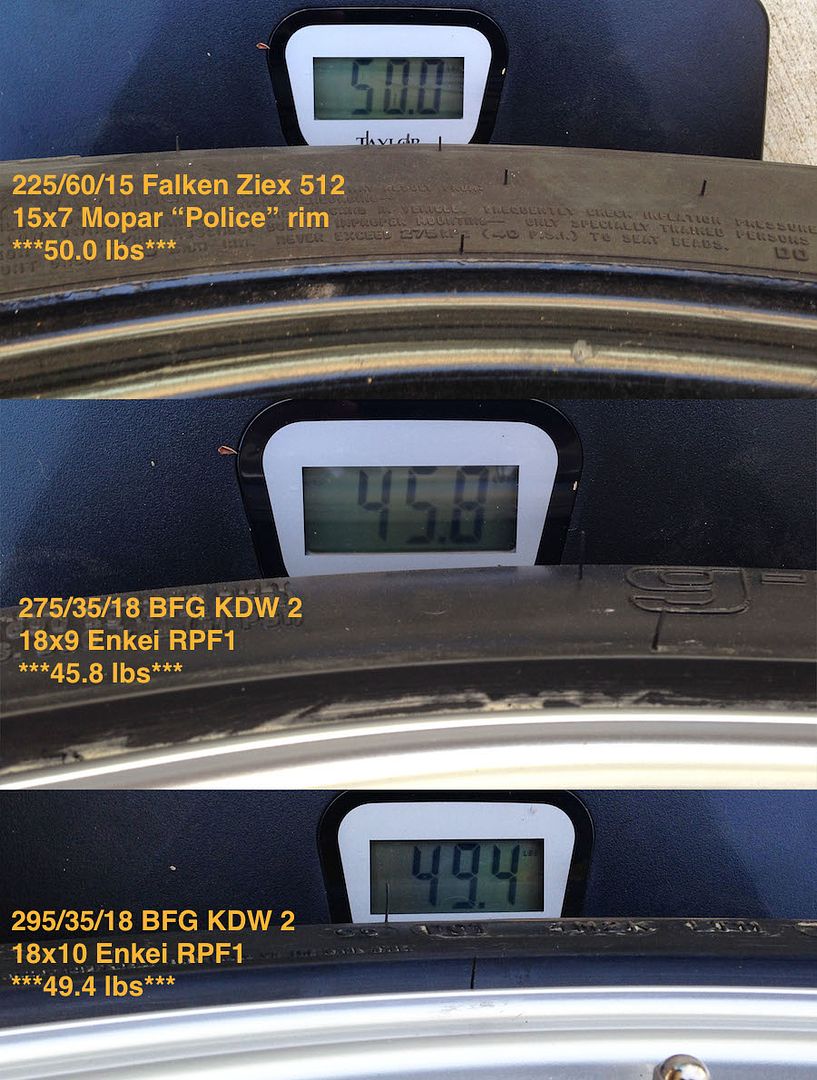Not necessarily.
I've heard from a few people that going to larger rims, 17's, 18's etc, hurts performance because the wheels weigh more. Although it's hard to argue that the additional traction from running a wider, modern compound tire isn't worth it, I really didn't buy it. But, I also didn't have any proof other than adding up manufacturer's specs. Until now.
So, what I had to compare was your basic 15x7 police wheel. Nothing fancy, pretty similar to a lot of the stock steel rims. On it I had a 225/60/15 Falken Ziex 512. Maybe not the lightest tire out there, but pretty average at about 25lbs. To compare to that, I had a 275/35/18 BFG KDW 2 on an 18x9" Enkei RPF1. One of the lighter rims out there for sure, but not the lightest. Also, a 295/35/18 on an 18x10 Enkei RPF1. The 18x9 weighs in at 17.1 lbs, the 18x10 at 18.45 lbs. The rims are light for sure, but those are MUCH wider tires.
I found the police wheel and tire to weigh 50 lbs. Definitely not all the light. And then things got interesting. The 275/35/18 on 18x9 weighed in at 45.8 lbs. That's 4.2 lbs lighter per wheel, not a small margin, especially talking about rotating mass. The 295? It weighed in at 49.4 lbs. Half a pound lighter than the little 225/60/15 on a 15x7" rim.

Obviously, not the "end all be all". The RPF1's are very light for their size, so there are no doubt 18's out there that would be heavier. And the Falken's may not be the lightest 225/60/15 you can get. But, considering the difference in tire size, there are more than a few 18" combo's out there that would be lighter than the stock steelies, even running relatively small 225/60/15's.
Just how much bigger is a 295/35/18 than a 225/60/15? A LOT bigger.

I've heard from a few people that going to larger rims, 17's, 18's etc, hurts performance because the wheels weigh more. Although it's hard to argue that the additional traction from running a wider, modern compound tire isn't worth it, I really didn't buy it. But, I also didn't have any proof other than adding up manufacturer's specs. Until now.
So, what I had to compare was your basic 15x7 police wheel. Nothing fancy, pretty similar to a lot of the stock steel rims. On it I had a 225/60/15 Falken Ziex 512. Maybe not the lightest tire out there, but pretty average at about 25lbs. To compare to that, I had a 275/35/18 BFG KDW 2 on an 18x9" Enkei RPF1. One of the lighter rims out there for sure, but not the lightest. Also, a 295/35/18 on an 18x10 Enkei RPF1. The 18x9 weighs in at 17.1 lbs, the 18x10 at 18.45 lbs. The rims are light for sure, but those are MUCH wider tires.
I found the police wheel and tire to weigh 50 lbs. Definitely not all the light. And then things got interesting. The 275/35/18 on 18x9 weighed in at 45.8 lbs. That's 4.2 lbs lighter per wheel, not a small margin, especially talking about rotating mass. The 295? It weighed in at 49.4 lbs. Half a pound lighter than the little 225/60/15 on a 15x7" rim.

Obviously, not the "end all be all". The RPF1's are very light for their size, so there are no doubt 18's out there that would be heavier. And the Falken's may not be the lightest 225/60/15 you can get. But, considering the difference in tire size, there are more than a few 18" combo's out there that would be lighter than the stock steelies, even running relatively small 225/60/15's.
Just how much bigger is a 295/35/18 than a 225/60/15? A LOT bigger.

















